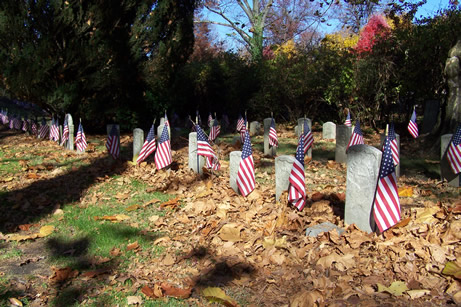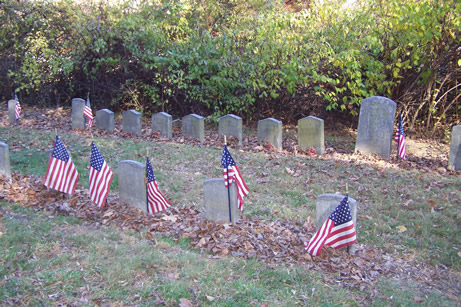

Study Areas
Masthead image from the Harrisburg Evening Telegraph during the war years.
An Hour Among the Soldier's Graves
Original article from the Harrisburg Evening Telegraph, 4 May 1863
The fine weather has no more beautiful effect anywhere than that which is produced by the first balmy atmosphere of spring among the graves. In the cemetery, summer is shedding its holiest beauty, and, assisted by the hand of affection, is decking the graves in flowers and perfumery distilling vines. On Sunday last we visited the Harrisburg Cemetery, where we noticed many people watching by the graves of those they loved in life and now mourn in death, while others were lingering among the tombs, some laughing gaily, indulging in jests illy fitting the occasion or the locality, and apparently little dreaming that beneath the cold sod they, too, some day would find a clayey pillow.
In the eastern corner of the cemetery a large lot has been specially appropriated to the burial of soldiers who died in the hospitals lately maintained in this city. Of these, there are over eighty now buried in that locality. The great majority of the graves are unmarked; the hard dry clay, baked and cracked by the heat of the sun, makes the spot look sad and dreary, and when one thinks of the fate of those who rest there, how they went out earnest and valiant in the cause of freedom, and how they were struck down by the minions of slavery, it would seem as if their graves should at least be adorned as if their memories were regarded with affection. All around where these warriors lie thus neglected, are the monuments of the proud, piercing the air in stately grandeur, and recording virtues in men and women now dead, which never animated their souls while living. But such is the vanity and the ingratitude of the world. To live, often is to struggle with a hard fate—is to indulge in vice and become steeped in crime—and to die is to find a grave where memory is neglected, or where unearned fame is to be inscribed above man’s resting place.
We made a note of the few graves in the locality alluded to, that were marked, of which the following is the description: David, son of Joshua and Barbara Ware, died January 21, 1863, aged 26 years, 2 months and 21 days—a native of Venango county.
This is a very respectable tombstone, evidently erected by friends of the deceased soldier. Immediately opposite is a grave marked by a rude and decaying board, with this simple inscription: Jacob G. Smith died October 30, 1862.
The inscription was put on with a stencil, and is roughly though kindly executed. Not far from this is another board, also a mere broken piece of paling, with this simple name: S. C. Parsons.
Passing on by this grave, we noticed a withered plant with a piece of paper attached, lying on another grave close by. On examination, the plant proved to be a decayed lily, and on the paper appeared the name of “Miss Emma Alice Graybill.” It was a touching tribute to the dead, and withered as was that flower, it had a beauty to our eyes with which the choicest exotic would fail to impress us. Who knows but it was left there to exhale its perfume on the grave of this unknown soldier by one who adored his valor while living, and thus breathed out her love for her hero when dead. Beyond this grave was one marked by a rough board on which appeared the name: C. Singler, died Nov. 28, 1861, a private of Captain Chase’s company, 57th P.V.
Off from this was a marble stone on which was engraved: C. C. Harvy— without either the regiment or time of death of the soldier. Standing alone among a number of unmarked graves is a stone with the inscription: Wisconsin Rears This Stone In memory of Nathaniel Delamaker, of Bragg’s Rifle, 6th Reg. Wisconsin Volunteers.—Who died at Camp Curtin, Harrisburg, Pennsylvania, August 1st, 1862.
Beside this elegant stone is the traitor’s grave, with a pine board for his monument, on which is rudely traced the words Manly C. Casto, 18th Va. Reg., Col. A. Jackson, Lewis county, Va.
Then we have the grave of a loyalist thus marked by some kind friend, with a fine stone, on which is inscribed: In Memory of Henry J., Son of John and Jane Ann Spackman. Died August 9, 1862, aged 24 years, 6 months and 26 days. He belonged to Company C., 5th Regiment P. R. V. C.
At the head of one of the graves was a board on which was placed a piece of paper, and this was covered with a common glass-light, secured by putty on its four sides. On the paper was written: S. B. Richardson, died Jan. [the date washed out by the water running beneath the glass] 1862. [Two other lines were visible, but so faded as to be illegible].
A rebel’s grave had a board to mark it, on which we read the words: William Price—Oct 4, 1862—Fulton, Ga., 7th Ga., aged 24 years. Along side lay another Georgian, marked also by a board, on which was carved only E. S. I.—Ga.
Then again a marble stone thus inscribed, Almond B. Gefford, died Dec. 8, 1861—aged 21 years and 8 days. The last grave we looked upon had but the simple board for its monument, and over this these words appeared: Sterling F. Semerill, Co. D, 177th Reg. P.V., died Dec 9, 1862, Luzerne county, Pa.
Out of over eighty graves, these were only marked as we have thus hurriedly described them. The rest will doubtless never be marked. In a very short time no one will know who reposes beneath the sod in that locality. Future generations only will know that some of those who fell opposing tyranny rest there, and will not future generations also blush to think and see the ingratitude with which they were buried? These gallant heroes must rest without a monument or so much even as a board to tell their names. And yet they rest in glorious graves!

Recent photo of the Soldier's Lot. Photo by George F. Nagle
The original news article featured above was printed in Harrisburg's Republican newspaper, the Telegraph, which was printed by local Republican stalwart George Bergner. In fact, Bergner is possibly the unidentified author who took a springtime stroll through the Harrisburg Cemetery to view the Soldier's Lot, only to find it in a "sad and dreary" state.
For years after the war, the graves remained unmarked, as noted in the Annual Report of the War Department, dated 30 November 1870. In reporting on the state of veteran burials around the country, the Soldier's Lot in Harrisburg is listed as follows:
HARRISBURG CEMETERY. (INCORPORATED.)
Situated at Harrisburg, Dauphin County, Pennsylvania, one hundred and six miles from Philadelphia.
Land high and rolling, presenting a handsome appearance. The main cemetery is well inclosed, which affords ample protection to the soldiers' graves therein; no head boards; list of names complete; 155 interments. (page 236)

Another photo, taken in November 2010. The stones with the angled tops, in the rear row, mark the graves of Confederate soldiers. Manly Casto, mentioned in the 1863 article above, is not among the identified dead buried in Harrisburg. Photo by George F. Nagle
Article transcribed by George F. Nagle
